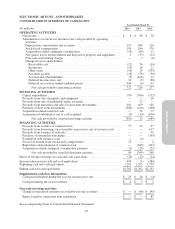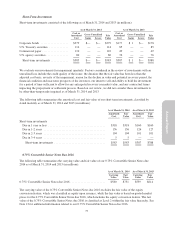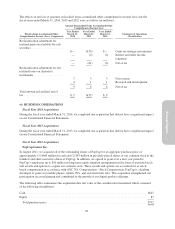Electronic Arts 2014 Annual Report Download - page 141
Download and view the complete annual report
Please find page 141 of the 2014 Electronic Arts annual report below. You can navigate through the pages in the report by either clicking on the pages listed below, or by using the keyword search tool below to find specific information within the annual report.
Annual Report
Concentration of Credit Risk, Significant Customers and Channel Partners
We extend credit to various retailers and channel partners. Collection of trade receivables may be affected by
changes in economic or other industry conditions and may, accordingly, impact our overall credit risk. Although
we generally do not require collateral, we perform ongoing credit evaluations of our customers and maintain
reserves for potential credit losses. Invoices are aged based on contractual terms with our customers. The
provision for doubtful accounts is recorded as a charge to general and administrative expense when a potential
loss is identified. Losses are written off against the allowance when the receivable is determined to be
uncollectible. Worldwide, we had three customers who accounted for approximately 17 percent, 15 percent, and
11 percent and two customers who accounted for 13 percent and 10 percent of our consolidated gross receivables
as of March 31, 2014 and 2013, respectively. We did not have any additional customers that exceeded 10 percent
of our consolidated gross receivables as of March 31, 2014 and 2013.
A majority of our sales are made to major retailers and distributors. During the fiscal year ended March 31, 2014,
approximately 68 percent of our North America net revenue was derived from our top ten customers. Though our
products are available to consumers through a variety of retailers and directly through us, the concentration of
our sales in one, or a few, large customers could lead to a short-term disruption in our sales if one or more of
these customers significantly reduced their purchases or ceased to carry our products.
Currently, a majority of our revenue is derived through sales of products and services on hardware consoles from
Sony and Microsoft. For the fiscal year ended March 31, 2014 (the fiscal year in which the PlayStation 4 and
Xbox One were released), 55 percent of our net revenue was for products and services on Sony’s PlayStation 3
and 4 and Microsoft’s Xbox 360 and One consoles (combined across all four platforms). In the fiscal years ended
March 31, 2013 and 2012, 60 percent and 61 percent of our net revenue was for products and services on the
PlayStation 3 and Xbox 360 combined. These platform partners have significant influence over the products and
services that we offer on their platform. Our agreements with Sony and Microsoft typically give significant
control to them over the approval, manufacturing and distribution of our products and services, which could, in
certain circumstances, leave us unable to get our products and services approved, manufactured and provided to
customers.
Short-term investments are placed with high quality financial institutions or in short-duration, investment-grade
securities. We limit the amount of credit exposure in any one financial institution or type of investment
instrument.
Royalties and Licenses
Royalty-based obligations with content licensors and distribution affiliates are either paid in advance and
capitalized as prepaid royalties or are accrued as incurred and subsequently paid. These royalty-based obligations
are generally expensed to cost of revenue generally at the greater of the contractual rate or an effective royalty
rate based on the total projected net revenue for contracts with guaranteed minimums.
Each quarter, we also evaluate the expected future realization of our royalty-based assets, as well as any
unrecognized minimum commitments not yet paid to determine amounts we deem unlikely to be realized through
product sales. Any impairments or losses determined before the launch of a product are generally charged to
research and development expense. Impairments or losses determined post-launch are charged to cost of revenue.
We evaluate long-lived royalty-based assets for impairment generally using undiscounted cash flows when
impairment indicators exist. Unrecognized minimum royalty-based commitments are accounted for as executory
contracts, and therefore, any losses on these commitments are recognized when the underlying intellectual
property is abandoned (i.e., cease use) or the contractual rights to use the intellectual property are terminated.
Advertising Costs
We generally expense advertising costs as incurred, except for production costs associated with media
campaigns, which are recognized as prepaid assets (to the extent paid in advance) and expensed at the first run of
71
























